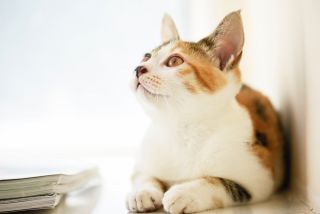Animal Behavior
Are Cats Actually Easy Pets?
Yes, but only if you're not concerned about their welfare.
Posted December 14, 2022 Reviewed by Vanessa Lancaster
Key points
- Cats can miss out on things they need because people think they are easy pets.
- Issues for pet cats include the house not being set up for them and people not taking them to the vet.
- Most cats would also like more attention from their owner, but on their own terms.

Cats make wonderful pets. They are fun and cuddly, and independent. What’s better than relaxing for an evening with a cat on your lap while you watch a favourite TV show or read a book?! Unfortunately, there are a lot of stereotypes about cats, and most of them are negative.
Although cat lovers know the stereotypes aren’t true, sometimes cultural beliefs about cats can still creep into the way we care for them. One of these, in particular, can be bad for cats: the idea that cats are easy pets and don’t need their owner to do much for them.
Perhaps because of this idea, many people don’t do as much for their cats as they could. It’s true that cats are much more tolerant of us going out to work than dogs are, and you don’t have to walk them every day like you would a dog. But if you’re willing to do more for your cat, you could be getting more out of our relationship with them. Here are some of the things many people don’t get quite right.
Setting Your Home up for Your Cat
When you look at things from your cat’s perspective, one thing that many people don’t pay enough attention to is the provision of the cat’s things in the home. Cats don’t just need food and litter boxes. They also need good scratching posts and places to hide and perch.
You can follow a set of guidelines called the five pillars of a healthy feline environment (Ellis et al. 2013), but many people aren’t meeting these needs.
A few years ago, scientists published the results of a study in which they consulted experts on cats and concluded that many pet cats have behaviour issues because their home is not set up right for them (Rioja-Lang et al. 2019). They said this is the biggest welfare issue for pet cats because if you don’t get these things right, your cat may become stressed or bored, which may manifest in behavior issues. If you have more than one cat, it’s especially important to make sure each cat has their own stuff (and can access it without having to fight or push past the other cat).
These days most people know the rule of thumb that you should have one litter box per cat plus one spare. A common mistake is to put them all in the same room. This effectively makes it the equivalent of one because if the cat can’t easily access the room—a person is using the bathroom where it is kept, for example, or another cat is in the hall outside blocking the doorway—there isn’t another one they can get access to.
Help Your Cat Go to the Vet
Pet cats also miss out when it comes to trips to the vet, partly because people find the whole experience so stressful, from getting the cat in the carrier and waiting in a room with other animals to seeing their cat stressed during the vet exam (Caney et al. 2022). Luckily there’s increasing awareness that you can train your cat to go in the carrier, even if they are currently terrified of it. Many veterinarians are also taking steps to reduce stress for your cat. Find a Cat-Friendly Practice and/or Fear Free Certified vet, and you know they will make the visit as stress-free for your cat as possible. So there’s a lot that you can do to make vet visits easier.
Give Your Cat Attention (of the Right Kind)
Contrary to the stereotypes of cats as loners, a well-socialized pet cat likes to be around you. For example, maybe they choose to be in the same room as you, sit next to you on the sofa, or sleep on your bed at night. There’s a clue that cats might like more attention from their people in research on cats and the pandemic. What happened to cats when their owners had to stay at home more because of lockdowns?
In two studies, people reported that their cats adapted well, seemed to enjoy the extra attention, and had fewer behaviour issues (Shoesmith et al. 2021; Riggio et al. 2022). In another study, although two-thirds of people said there were no changes in their cat’s behavior, those who saw a change overwhelmingly found it to be positive (Jezierski et al. 2021).
So it’s quite likely that your cat would like more attention from you. Of course, cats like choice and control (like any creature), so let your cat have a choice whenever possible and learn to read their body language. Depending on the cat, they might not want more petting (see why petting can make some cats aggressive), but most cats would definitely like more interactive playtime, such as playing with the wand toy.
Improving Welfare for Cats
So what can you do to make your cat’s life better and improve your relationship with them? There are definitely some things people shouldn’t do to their cats, but there are also many things that will make your cat happier. Learning more about cats will help you understand them and what they need. You’ll find lots of tips in my book Purr: The Science of Making Your Cat Happy (including a plan to teach your cat to like their carrier)
It's unfortunate that there are so many stereotypes about cats that are simply not true and that are to the detriment of cats. Although I don’t know the origins of these stereotypes, it feels like some of them were created by people who dislike cats or don’t know them very well. Next time someone tells you that a cat is an easy pet, remember that everything works out better when you understand what your cat needs.
Facebook image: rock-the-stock/Shutterstock
LinkedIn image: wavebreakmedia/Shutterstock
References
Caney, S. M., Robinson, N. J., Gunn-Moore, D. A., & Dean, R. S. (2022). Happy cats: stress in cats and their carers associated with outpatient visits to the clinic. Journal of Feline Medicine and Surgery, 1098612X221121907.
Ellis, S. L., Rodan, I., Carney, H. C., Heath, S., Rochlitz, I., Shearburn, L. D., Sundahl, E. & Westropp, J. L. (2013). AAFP and ISFM feline environmental needs guidelines. Journal of Feline Medicine and Surgery, 15(3), 219-230.
Jezierski, T., Camerlink, I., Peden, R. S., Chou, J. Y., Sztandarski, P., & Marchewka, J. (2021). Cat owners’ perception on having a pet cat during the COVID-19 pandemic. PloS one, 16(10), e0257671
Riggio, G., Borrelli, C., Piotti, P., Grondona, A., Gazzano, A., Di Iacovo, F. P., Fatjó, J., Bowen, J.E., Mota-Rojas, D., Pirrone, F. & Mariti, C. (2022). Cat–Owner Relationship and Cat Behaviour: Effects of the COVID-19 Confinement and Implications for Feline Management. Veterinary sciences, 9(7), 369.
Rioja-Lang, F., Bacon, H., Connor, M., & Dwyer, C. M. (2019). Determining priority welfare issues for cats in the United Kingdom using expert consensus. Veterinary Record Open, 6(1).
Shoesmith, E., Santos de Assis, L., Shahab, L., Ratschen, E., Toner, P., Kale, D., Reeve, C. & Mills, D. S. (2021). The perceived impact of the first UK COVID-19 lockdown on companion animal welfare and behaviour: A mixed-method study of associations with owner mental health. International journal of environmental research and public health, 18(11), 6171.
Todd. Z. (2022). Purr: The Science of Making Your Cat Happy. https://www.amazon.com/Purr-Science-Making-Your-Happy/dp/1771648147/




